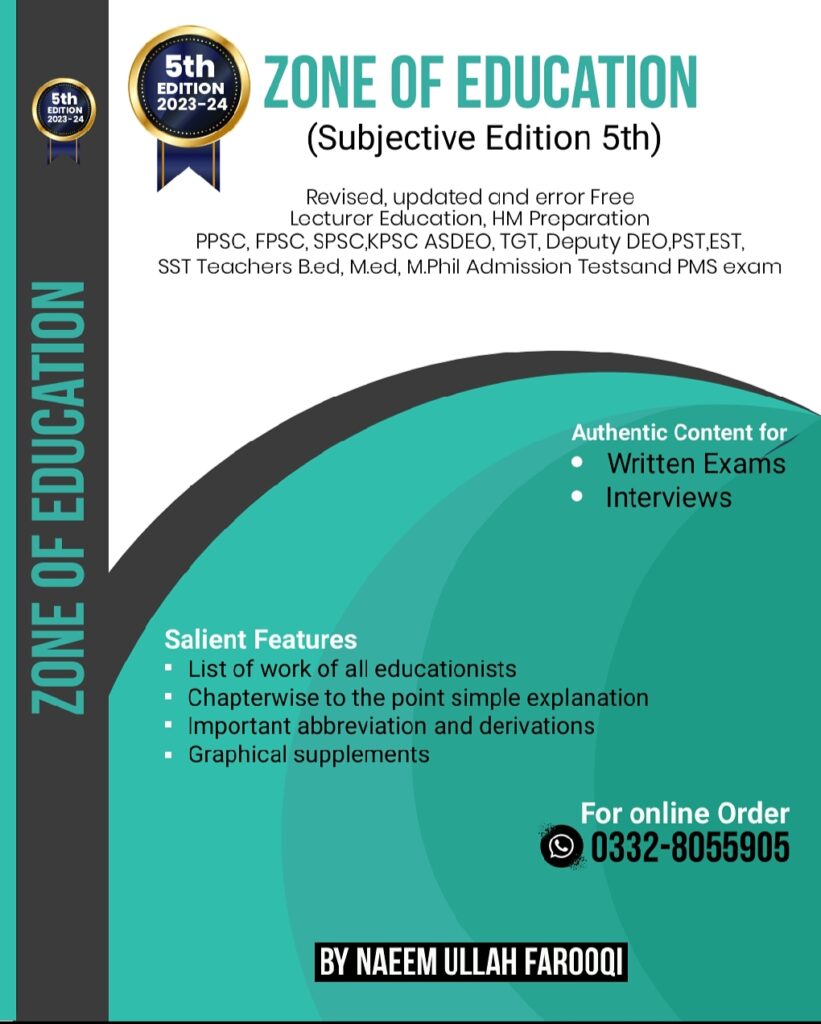Educational Research
31. What, according to Mouly, is “An experiment in reverse” refers to?
· (a) Field experiment
· (b) Ex post-facto research
· (c) Laboratory experiment
· (d) None of these
·
32. Which of the following is not correct about ex-post-facto research?
· (a) The dependent variable is measured first, and after that the independent variable or variables are studied.
· (b) It is possible to exercise much rigorous control in this and obtain highly valid results.
· (c) It is not possible in this research to assign the subjects to the treatment groups randomly.
· (d) It provides support for any number of different and sometimes contradictory hypotheses.
· Answer: (b) It is possible to exercise much rigorous control in this and obtain highly valid results.
33. Which of the following statements is most correct about the difference between Applied and Action Research?
· (a) While applied research adds to an organized body of scientific knowledge, action research does not do that.
· (b) While the findings of applied research have practical implications for educational practices, action research is not concerned with that.
· (c) While applied research and action research both are undertaken to solve immediate practical problems, in action research the researcher is the same person as the practitioner who will use the findings of the research.
· (d) The difference between them is that of nomenclature only; otherwise, they are the same.
· Answer: (c) While applied research and action research both are undertaken to solve immediate practical problems, in action research the researcher is the same person as the practitioner who will use the findings of the research.
34. If a researcher conducts research on finding out which administrative style contributes more to institutional effectiveness, it is an example of:
· (a) Basic research
· (b) Action research
· (c) Applied research
· (d) Fundamental research
· Answer: (c) Applied research
35. What does give? (X-x) N-1
· (a) Total variance
· (b) Variance between the groups
· (c) Within groups variance
· (d) None of these
·
36. What is the variance calculated by averaging the squared deviations of the group from the grand mean and dividing it by the degrees of freedom?
· (a) SS
· (b) SSA
· (c) SST
· (d) None of these
· Answer: (b) SSA
37. In case of ANOVA, if there are no treatment effects at all, then SSA will be equal to:
· (a) SS
· (b) SS
· (c) SS+SS
· (d) All of these
· Answer: (a) SS
38. In case of ANOVA, if there are no treatment effects at all, then F-ratio will be:
· (a) Zero
· (b) +10
· (c) -1.0
· (d) Any value between +1.0
·
39. What is the nature of the F-test?
· (a) Essentially a two-tailed test
· (b) Essentially a one-tailed test
· (c) Can be one-tailed as well as two-tailed depending on the hypothesis to be tested
· (d) Can never be a one-tailed test
· Answer: (b) Essentially a one-tailed test
40. Which is not a type of rating scale:
· (a) Descriptive scale
· (b) Rational scale
· (c) Numerical scale
· (d) Graphic scale
·
41. What is an ‘attitude’?
· (a) A special mental ability
· (b) An emotional mental state about some issue
· (c) A kind of feeling, free-floating and unattached to anything
· (d) An aptitude in other words
· Answer: (b) An emotional mental state about some issue
42. Who developed “The method of summated ratings” for measuring attitudes?
· (a) Chave in 1929
· (b) Thurstone in 1932
· (c) Likert
· (d) Thurstone and Chave both as coauthors
· Answer: (c) Likert
43. Who developed the Method of equal appearing intervals forming the basis of constructing attitude scales?
· (a) Likert
· (b) Thurstone and Chave
· (c) Bogardus
· (d) Guttman
· Answer: (b) Thurstone and Chave
44. What is an attitude scale with five points on it varying from strongly approved to strongly disapproved?
· (a) Likert type
· (b) Thurstone type
· (c) Bogardus type
· (d) Guttman type
· Answer: (a) Likert type
45. What is an attitude scale in which each item’s value is calculated by finding out the mean or median of the ratings of a large number of judges on an eleven-point rating scale?
· (a) Thurstone type
· (b) Guttman type
· (c) Bogardus type
· (d) Likert type
· Answer: (a) Thurstone type
46. Which of the following situations calls for the use of a ratio-scale?
· (a) A researcher waits to assert that the two persons X and V differ in their attitudes toward nationalization of education.
· (b) He wishes to state that the attitude of one person ‘X’ is more favorable than that of ‘Y.’
· (c) He wishes to make a statement that as compared to Y, “X’ is much more in favor of nationalization than he is, as compared to ‘Z.’
· (d) He wants to show that ‘X’ is twice as much in favor of Nationalization as ‘Y.’
· Answer: (d) He wants to show that ‘X’ is twice as much in favor of Nationalization as ‘Y.’
47. What is the scale on which the distance between scale positions are equal?
· (a) Ordinal scale
· (b) Nominal scale
· (c) Ratio scale
· (d) Interval scale
· Answer: (d) Interval scale
48. Which of the following is an example of the criterion-reference test?
· (a) The test is such as the score on it reveals what the position of an individual is in the group on which it has been standardized.
· (b) The test is such as the score on it reveals how much an individual has acquired in some specific area of learning as judged against some external criterion.
· (c) The test is such as its norms have been prepared on a sufficiently large sample.
· (d) The test is such as its reliabilities and validities have been established extensively.
· Answer: (b) The test is such as the score on it reveals how much an individual has acquired in some specific area of learning as judged against some external criterion.
49. Which is the characteristic of a norm-reference test?
· (a) It is objective-referenced or domain-referenced.
· (b) It tells to what extent instructional objectives have been achieved.
· (c) It has items that cluster around a few well-specified objectives.
· (d) It reveals where a particular individual stands in the group in regard to the trait being measured by the test.
· Answer: (d) It reveals where a particular individual stands in the group in regard to the trait being measured by the test.
50. Qualitative analysis is not, at all, used in:
· (a) Descriptive research
· (b) Ethnographical research
· (c) Experimental research
· (d) Historical research
· Answer: (c) Experimental research
51. Which of the following indicates that it is a parameter, not a statistic?
· (a) X
· (b) S
· (c) s
· (d) n
· Answer: (c) s
52. Which of the following statements about values is correct?
· (a) Obtained on the basis of the whole population, they are known as statistics.
· (b) Obtained from samples, they are known as parameters.
· (c) Obtained from populations, they are not known as statistics.
· (d) Obtained from samples, they are not known as statistics.
· Answer: (c) Obtained from populations, they are not known as statistics.
53. Which of the following statements is correct?
· (a) N is used for the number of cases or subjects in the sample.
· (b) µ (mew) is used for the mean of the total population.
· (c) s is used for the standard deviation of a sample.
· (d) S is used for the standard deviation of the population.
54. What should we do if we want to reduce both Type-I and Type-II errors?
· (a) Increase the level of significance.
· (b) Decrease the level of significance.
· (c) Increase the size of the sample.
· (d) Reduce the size of the sample.
· Answer: (c) Increase the size of the sample.
55. The level of significance (alpha) gives the probability of:
· (a) Mistakenly or falsely accepting Ho.
· (b) Mistakenly or falsely rejecting Ho.
· (c) Correctly rejecting Ho.
· (d) Correctly accepting Ho.
·
65. What yields a value known as:
· (a) Mean
· (b) Variance
· (c) Standard deviation
· (d) Standard error of the mean
·
66. What will be the Chi-square value in the following:
· Low: 5
· Average: 9, 10
· High: 7, 5
· (a) 1.4
· (b) 1.2
· (c) 1.1
· (d) 6.0
· Answer: (c) 1.1
67. When an investigator uses two or more variables in combination to predict a single variable, he has to use:
· (a) Product moment correlation, r
· (b) Partial correlation, 12.3
· (c) Multiple correlation, R1.23
· (d) Rank order correlation
· Answer: (c) Multiple correlation, R1.23
68. Which is NOT correct about the notation R1.23?
· (a) Subscript 1 stands for the criterion variable to be predicted.
· (b) Subscript 2 stands for the independent variable no. 1.
· (c) Subscript 3 stands for the independent variable no. 2.
· (d) Subscript 1 stands for the variable to be partialled out.
· Answer: (d) Subscript 1 stands for the variable to be partialled out. (Subscript 1 represents the criterion variable to be predicted, not the variable to be partialled out.
JOIN ZONE OF EDUCATIONPK!
Discover the most comprehensive and reliable pedagogy resources in Pakistan, curated for competitive exam success. Our content covers all competitive exam MCQs, including PPSC, FPSC, AJKPSC, SPSC, and more. Designed to empower learners with top-notch material and insights, trust us for your preparation journey!


